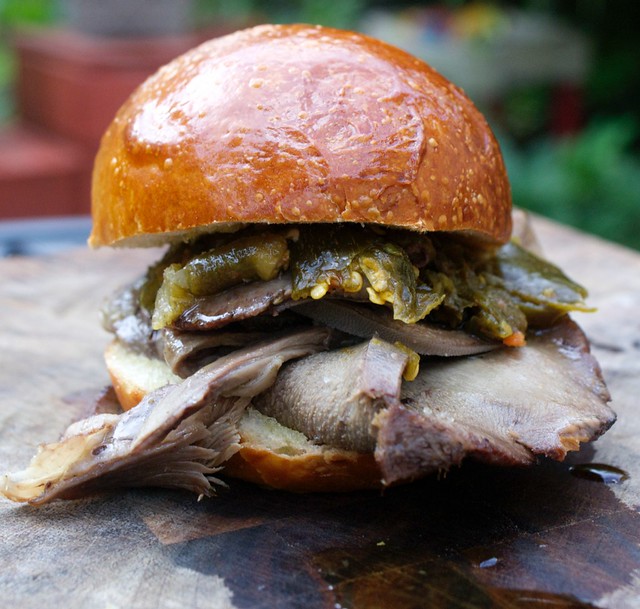With a large and growing cookbook collection, I get asked by friends who may not have the same cookbook issues, “How do you choose which book to cook from – much less what to cook from the book you choose?” This has to be a common question. My answer – I will grab a book based on what I have at home or based on what the season is. Sometimes, I will see something online which will push me to get back into a book. When I do find a book, the driving force behind picking a recipe is almost always a new technique or ingredient I want to try. In this case, there was a technique which included boiling beef tongue after smoking it. I was skeptical. Won’t you boil off any smoke flavors? Wouldn’t the other way be better? I had to try it for myself.
This preparation of beef tongue comes from the new The New Charcuterie Cookbook by Jamie Bissonnette who cooks at Toro in New York and Coppa and Toro in Boston. The book packs in a lot of really interesting cured, smoked, encased and variety meats into a small book and runs the gamut of time-intensive cured and dried sausages to offal tacos. It reads almost like a DIY handbook, fast and dense.
With the guidance within the book, I went to work on a tongue from The Butcher & Larder. First poking holes with a needle to more quickly cure the tongue , then mixing and applying the cure. After a few days, and a few turns in the salty cure, I dried the tongue overnight to prepare it for the cold smoke.
I lit a chimney of coals and tossed in a few logs of apple wood to cold smoke the tongue. With full trust, I laid the cold smoked tongue, still floppy and uncooked, over chopped onions, carrot and celery and covered the tongue with water. After simmering the tongue for a few hours, the house smelled of wood smoke, the water smelled of wood smoke and most importantly the tongue, which has been chilled quickly in an ice bath, smelled still of smoke.
I peeled the tongue while it was still warm and then chilled it overnight in the fridge. In a perfect world, I would have sliced the tongue with a meat slicer to get the perfectly thin and consistent slices. I live in a world with limitations however, so I sliced it into ruddy and inconsistently thin slices by hand. The cold slices reminded me of subtly smokey deli roast beef in flavor, so I grabbed a challah roll, added some cold, sliced tongue and topped it with Bari giardiniera.
Upon tasting it, it was lovely, but the addition of the giardiniera made me consider this more like Italian beef, so I steamed some of the smoked tongue and added it to challah roll #2, adding giardiniera again. This was the ticket. It was beefy with a softer texture. The thin slices kept it from being chewy. The smokiness gave it a very savory quality, but it was balanced and not in your face like BBQ or bacon. Bissonnette nails it when he says the things some people don’t like about tongue are solved by cooking it and slicing it like this.
The little bit which grabbed me when I read this recipe was the smoke then boil technique. I was admittedly skeptical about boiling after cold-smoking, but I am a believer. I just had to try it first.
Smoked Beef Tongue
From The New Charcuterie Cookbook by Jamie Bissonnette
(italicized notes are mine)
1 fresh beef tongue, about 3 lb (1 kg)
For the Cure:
2 cups kosher salt
1 cup sugar
2 tbsp coriander
2 tbsp whole black peppercorns
2 tsp chili flakes
2 tbsp fennel seed
1 tsp caraway
Smoking chips (I used Apple Wood Chunks)
2 cups mirepoix
Use the jacquard (I used a needle) to punch the whole tongue evenly about 20 times. Rub the tongue in the cure mix and refrigerate it for 48 hours.
Set the chips on fire using one pan, then smother the fire with a small amount of water. Transfer the smoldering chips to the bottom half of a two-part perforated/nonperforated pan. Put the tongue in the top, then cover it tightly with tin foil. Poke 1 or 2 small holes in tin foil for smoke to escape. Cold smoke for 1 hour. (I used my cold smoking set up because I have one.)
Place the tongue in a stockpot and cover with 1 inch (2.5 cm) of water. Add mirepoix. Bring to a boil, then turn down to just above simmer and cook 2 hours.
Remove the tongue and cool it in an ice bath. When it’s cool enough to handle, peel off the outer skin. Wrap the tongue in plastic wrap and store in the refrigerator.
When ready to serve the tongue, slice it thin like deli meat for sandwiches or cut thick slices and grill. This also works nicely warmed up with chicken stock and
served with lentils.










Very cool, I love me some tongue…When you say you cold smoked it, what temp was your grill at, and how did you keep it cold? I’ve seen a hack where you can take a soldering iron, and have it cause the combustion on the wood chips without heating up the whole grill